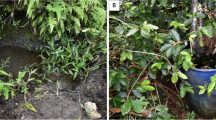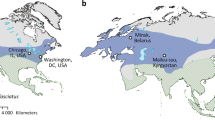Abstract
Culex torrentium and C. vagans are morphologically similar mosquito species for which the name C. exilis has been used in Russia for a long time. We have compared the male genitalia in these species and analyzed the genetic differences between them, using specimens from different parts of their ranges. The results show that C. vagans can be readily distinguished from C. torrentium by the shape of the lateral arms of the phallosome. The genetic differences between the species are 3.5–3.6% for the COI gene and 14% for the ITS2 nuclear marker and reliably differentiated the two species. The ITS2 sequence of C. vagans is determined for the first time. The data obtained can be used to identify C. vagans and C. torrentium and to specify their ranges.




Similar content being viewed by others
Notes
The balsam slides of Culex torrentium from Orenburg, Tomsk, Yessentuki, Kislovodsk, and Leningrad Province (nos. 277, 1169, 1400) were labeled as Culex exilis or Culex exilis = C. torrentium.
REFERENCES
Abramson, N.I., Phylogeography: results, problems, and prospects, Vestn. Vavilov. Ob-va Gen. Selekts., 2007, vol. 11, no. 2, p. 307.
Becker, N., Jost, A., and Weitzel, T., The Culex pipiens complex in Europe, J. Am. Mosq. Control Assoc., 2012, vol. 28, no. 4s, p. 53. https://doi.org/10.2987/8756-971X-28.4s.53
Budaeva, I.A., Kolupaev, A.S., Veslevskaya, E.Yu., and Bolgova, A.V., On taxonomic composition and the level of knowledge of mosquitoes (Diptera, Culicidae) in Voronezh Province, in Sovremennye problemy zoologii i parazitologii (Current Problems in Zoology and Parasitology), Gaponova, S.P., Ed., Voronezh: Voronezh. Gos. Univ., 2014, p. 21.
Chong, Y.J. and Wada, Y., Seasonal prevalence of the vector mosquitoes of Japanese encephalitis virus in Kyungpook Province, Korea, Korean J. Parasitol., 1985, vol. 23, no. 1, p. 139.
Dahl, C., Taxonomic studies on Culex pipiens and Culex torrentium, Biosyst. Haematophagous Insects, 1988, vol. 37, p. 149.
Danabalan, R., Ponsonby, D.J., and Linton, Y.M., A critical assessment of available molecular identification tools for determining the status of Culex pipiens s. l. in the United Kingdom, J. Am. Mosq. Control Assoc., 2012, vol. 28, no. 4s, p. 68. https://doi.org/10.2987/8756-971X-28.0.68
Edwards, F.W., Una revisione delle zanzare delle regioni paleartiche, Riv. Malariol., 1926, vol. 5, p. 1.
Fedorova, M.V. and Shaikevich, E.V., Morphological and molecular-genetic distinctions between adult mosquitoes Culex torrentium Martini and C. pipiens Linnaeus (Diptera, Culicidae) from Moscow Province, Entomol. Obozr., 2007, vol. 86, no. 1, p. 32.
Gornostaeva, R.M., List of mosquitoes (family Culicidae) of European Russia, Parazitologiya, 2000, vol. 34, no. 5, p. 428.
Gutsevich, A.V., Monchadsky, A.S., and Stackelberg, A.A., Fauna SSSR. Nasekomye dvukrylye (Fauna of the USSR. Insecta, Diptera), Vol. 3, Issue 4, Leningrad: Nauka, 1970.
Harbach, R., The mosquitoes of the subgenus Culex in Southwestern Asia and Egypt (Diptera: Culicidae), Contrib. Am. Entomol. Inst., 1988, vol. 24, no. 1, p. 1.
Harbach, R., Classification within the cosmopolitan genus Culex (Diptera: Culicidae): The foundation for molecular systematics and phylogenetic research, Acta Trop., 2011, vol. 120, no. 1, p. 1. https://doi.org/10.1016/j.actatropica.2011.06.005
Hesson, J.C., Rettich, F., Merdíc, E., Vignjevíc, G., Ostman, O., Schäfer, M., Schaffner, F., Foussadier, R., Besnard, G., Medlock, J., Scholte, E.-J., and Lundström, J.O., The arbovirus vector Culex torrentium is more prevalent than Culex pipiens in northern and central Europe, Med. Vet. Entomol., 2014, vol. 28, p. 179.
Karthika, P., Vadivalagan, C., Thirumurugan, D., Kumar, R.R., Murugan, K., Canale, A., and Benelli, G., DNA barcoding of five Japanese encephalitis mosquito vectors (Culex fuscocephala, Culex gelidus, Culex tritaeniorhynchus, Culex pseudovishnui and Culex vishnui), Acta Trop., 2018, vol. 183, p. 84. https://doi.org/10.1016/j.actatropica.2018.04.006
Khalin, A.V., Three-dimensionality of the male genitalia shape and species identification in the mosquito genus Aedes Meigen, 1818 (Diptera, Culicidae), Parazitologiya, 2009, vol. 43, no. 5, p. 389.
Kukharchuk, L.P., Krovososushchie komary (Diptera, Culicidae) Sibiri. Sistematika (Mosquitoes (Diptera, Culicidae) of Siberia: Taxonomy), Novosibirsk: Nauka, 1980.
Leggewie, M., Badusche, M., Rudolf, M., Jansen, S., Börstler, J., Krumkamp, R., Huber, K., Krüger, A., Schmidt-Chanasit, J., Tannich, E., and Becker, S.C., Culex pipiens and Culex torrentium populations from Central Europe are susceptible to West Nile virus infection, One Health, 2016, vol. 2, p. 88. https://doi.org/10.1016/j.onehlt.2016.04.001
Maekawa, Y., Ogawa, K., Komagata, O., Tsuda, Y., and Sawabe, K., DNA barcoding for molecular identification of Japanese mosquitoes, Med. Entomol. Zool., 2016, vol. 67, no. 3, p. 183. https://doi.org/10.7601/mez.67.183
Malkova, M.G., Yakimenko, V.V., Vinarskaya, N.P., Nemchinova, N.N., and Mikhailova, O.A., Krovososushchie komary Zapadnoi Sibiri: fauna, sistematika, osobennosti ekologii, metody polevykh i laboratornykh issledovanii: metodicheskoe posobie (Mosquitoes of West Siberia: A Guide to Their Fauna, Taxonomy, Ecological Features, and Methods of Field and Laboratory Study), Omsk: Omskii Nauchnyi Vestnik, 2013.
Mattingly, P.F., Mosquitoes (Diptera: Culicidae) from the Tropical Institute at Hamburg, Proc. R. Entomol. Soc. London Ser. B Taxon., 1955, vol. 24, p. 27.
Miller, B.R., Crabtree, M.B., and Savage, H.M., Phylogeny of fourteen Culex mosquito species, including the Culex pipiens complex, inferred from the internal transcribed spacers of ribosomal DNA, Insect Mol. Biol., 1996, vol. 5, p. 93. https://doi.org/10.1111/j.1365-2583.1996.tb00044.x
National Center for Biotechnology Information. https://www.ncbi.nlm.nih.gov
Platonov, A.E., Tolpin, V.A., Gridneva, K.A., Titkov, A.V., Platonova, O.V., Kolyasnikova, N.M., Busani, L., and Rezza, G., The incidence of West Nile disease in Russia in relation to climatic and environmental factors, Int. J. Environ. Res. Public Health, 2014, vol. 11, no. 2, p. 1211. https://doi.org/10.3390/ijerph110201211
Porter, C.H. and Collins, F.H., Species-diagnostic differences in a ribosomal DNA internal transcribed spacer from the sibling species Anopheles freeborni and Anopheles hermsi (Diptera: Culicidae), Am. J. Trop. Med. Hyg., 1991, vol. 45, p. 271.
Putintseva, E.V., Alekseichik, I.O., Chesnokova, S.N., Udovichenko, S.K., Borodai, N.V., Nikitin, D.N., Agarkova, E.A., Baturin, A.A., Shpak, I.M., Fomina, V.K., Nesgovorova, A.V., Smelyansky, V.P., Viktorov, D.V., and Toporkov, A.V., Results of the West Nile fever agent monitoring in Russia in 2019 and the forecast of epidemic situation development in 2020, Probl. Osobo Opasnykh Infekts., 2020, no. 1, p. 51.
Ramsdale, C.D., Alten, B., Çaglar, S.S., and Ozer, N., A revised, annotated checklist of the mosquitoes (Diptera, Culicidae) of Turkey, Eur. Mosq. Bull., 2001, vol. 9, p. 18.
Shaikevich, E.V., PCR-RFLP of the COI gene reliably differentiates Cx. pipiens, Cx. pipiens f. molestus and Cx. torrentium of the pipiens complex, Eur. Mosq. Bull., 2007, vol. 23, p. 25.
Shaikevich, E.V., Genetic identification of closely related insect species and the role of symbionts in their evolution, by the example of the Culex pipiens species complex and Adalia spp., Extended Abstract of Doctoral Dissertation in Biology, Moscow, 2015.
Shaikevich, E.V. and Zakharov, I.A., Polymorphism of mitochondrial COI and nuclear ribosomal ITS2 in Culex pipiens complex and in Culex torrentium (Diptera, Culicidae), Comp. Cytogen., 2010, vol. 4, no. 2, p. 161. https://doi.org/10.3897/compcytogen.v4i2.45
Simon, C., Frati, F., Beckenbach, A., Crespi, B., Liu, H., and Flook, P., Evolution, weighting, and phylogenetic utility of mitochondrial gene sequences and a compilation of conserved polymerase chain reaction primers, Ann. Entomol. Soc. Am., 1994, vol. 87, no. 6, p. 651.
Supin, V.I., Mosquitoes (Diptera, Culicidae) of the East Transbaikalia, Extended Abstract of Candidate’s Dissertation in Biology, Moscow, 1983.
Tamura, K., Stecher, G., Peterson, D., Filipski, A., and Kumar, S., MEGA6: Molecular Evolutionary Genetics Analysis version 6.0, Mol. Biol. Evol., 2013, vol. 30, p. 2725. https://doi.org/10.1093/molbev/mst197
Vinogradova, E.B., Mosquitoes of the Culex pipiens complex in Russia: taxonomy, distribution, ecology, physiology, genetics, economic importance, and control, Tr. Zool. Inst. Ross. Akad. Nauk, 1997, vol. 271, p. 1.
Vinogradskaya, O.N., On the finding of Culex torrentium Martini (Culex exilis Dyar) in Moscow area, Med. Parazitol. Parazit. Bolezni, 1970, no. 4, p. 502.
Wang, G., Li, C., Guo, X., **ng, D., Dong, Y., Wang, Z., Zhang, Y., Liu, M., Zheng, Z., Zhang, H., Zhu, X., Wu, Z., and Zhao, T., Identifying the main mosquito species in China based on DNA barcoding, PLoS One, 2012, vol. 7, no. 10: e47051. https://doi.org/10.1371/journal.pone.0047051
Zittra, C., Flechl, E., Kothmayer, M., Vitecek, S., Rossiter, H., Zechmeister, T., and Fuehrer, H.-P., Ecological characterization and molecular differentiation of Culex pipiens complex taxa and Culex torrentium in Eastern Austria, Parasites Vectors, 2016, vol. 9, p. 197. https://doi.org/10.1186/s13071-016-1495-4
Funding
This work was carried out at the Core Facilities Center “Taxon,” using the taxonomic collection of ZIN, and financially supported by Additional State Assignment AAAA-A17117030310209-7 and 0112-2019-0002 “Genetic technologies in biology, medicine, agriculture, and nature management.”
Author information
Authors and Affiliations
Corresponding author
Ethics declarations
The authors declare that they have no conflict of interest. All the applicable international, national, and/or institutional guidelines for the care and use of animals were followed. All the procedures performed in studies involving animals were in accordance with the ethical standards of the institution or practice at which the studies were conducted.
Rights and permissions
About this article
Cite this article
Fedorova, M.V., Shaikevich, E.V., Sycheva, K.A. et al. Morphological and Genetic Differences between Mosquitoes Culex vagans Wiedemann, 1828 and Culex torrentium Martini, 1925 (Diptera, Culicidae). Entmol. Rev. 101, 767–777 (2021). https://doi.org/10.1134/S001387382106004X
Received:
Revised:
Accepted:
Published:
Issue Date:
DOI: https://doi.org/10.1134/S001387382106004X




